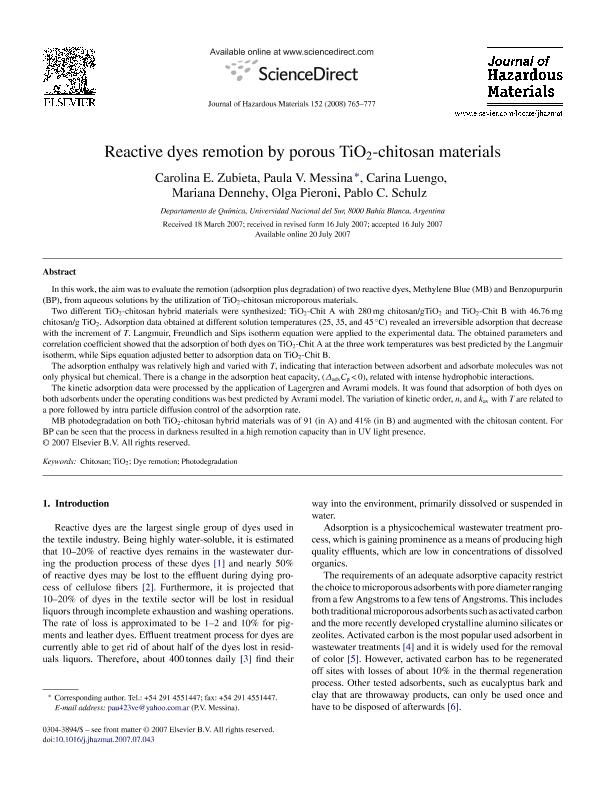Artículo
Reactive dyes remotion by porous TiO2-chitosan materials
Zubieta, Carolina Edith ; Messina, Paula Verónica
; Messina, Paula Verónica ; Luengo, Carina Vanesa
; Luengo, Carina Vanesa ; Dennehy, Mariana; Pieroni, Olga Inés; Schulz, Pablo Carlos
; Dennehy, Mariana; Pieroni, Olga Inés; Schulz, Pablo Carlos
 ; Messina, Paula Verónica
; Messina, Paula Verónica ; Luengo, Carina Vanesa
; Luengo, Carina Vanesa ; Dennehy, Mariana; Pieroni, Olga Inés; Schulz, Pablo Carlos
; Dennehy, Mariana; Pieroni, Olga Inés; Schulz, Pablo Carlos
Fecha de publicación:
04/2008
Editorial:
Elsevier Science
Revista:
Journal of Hazardous Materials
ISSN:
0304-3894
Idioma:
Inglés
Tipo de recurso:
Artículo publicado
Clasificación temática:
Resumen
In this work, the aim was to evaluate the remotion (adsorption plus degradation) of two reactive dyes, Methylene Blue (MB) and Benzopurpurin (BP), from aqueous solutions by the utilization of TiO2-chitosan microporous materials. Two different TiO2-chitosan hybrid materials were synthesized: TiO2-Chit A with 280 mg chitosan/gTiO2 and TiO2-Chit B with 46.76 mg chitosan/g TiO2. Adsorption data obtained at different solution temperatures (25, 35, and 45 °C) revealed an irreversible adsorption that decrease with the increment of T. Langmuir, Freundlich and Sips isotherm equation were applied to the experimental data. The obtained parameters and correlation coefficient showed that the adsorption of both dyes on TiO2-Chit A at the three work temperatures was best predicted by the Langmuir isotherm, while Sips equation adjusted better to adsorption data on TiO2-Chit B. The adsorption enthalpy was relatively high and varied with T, indicating that interaction between adsorbent and adsorbate molecules was not only physical but chemical. There is a change in the adsorption heat capacity, (ΔadsCp < 0), related with intense hydrophobic interactions. The kinetic adsorption data were processed by the application of Lagergren and Avrami models. It was found that adsorption of both dyes on both adsorbents under the operating conditions was best predicted by Avrami model. The variation of kinetic order, n, and kav with T are related to a pore followed by intra particle diffusion control of the adsorption rate. MB photodegradation on both TiO2-chitosan hybrid materials was of 91 (in A) and 41% (in B) and augmented with the chitosan content. For BP can be seen that the process in darkness resulted in a high remotion capacity than in UV light presence.
Palabras clave:
Chitosan
,
Dye Remotion
,
Photodegradation
,
Tio2
Archivos asociados
Licencia
Identificadores
Colecciones
Articulos(CCT - BAHIA BLANCA)
Articulos de CTRO.CIENTIFICO TECNOL.CONICET - BAHIA BLANCA
Articulos de CTRO.CIENTIFICO TECNOL.CONICET - BAHIA BLANCA
Articulos(IFISUR)
Articulos de INSTITUTO DE FISICA DEL SUR
Articulos de INSTITUTO DE FISICA DEL SUR
Articulos(INQUISUR)
Articulos de INST.DE QUIMICA DEL SUR
Articulos de INST.DE QUIMICA DEL SUR
Citación
Zubieta, Carolina Edith; Messina, Paula Verónica; Luengo, Carina Vanesa; Dennehy, Mariana; Pieroni, Olga Inés; et al.; Reactive dyes remotion by porous TiO2-chitosan materials; Elsevier Science; Journal of Hazardous Materials; 152; 2; 4-2008; 765-777
Compartir
Altmétricas



